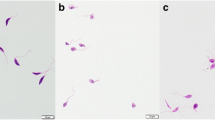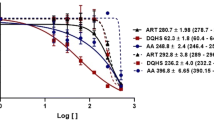Abstract
Leishmania donovani is the causative agent of visceral leishmaniasis. Annually, 500 million new cases of infection are reported mainly in poor communities, decreasing the interest of the pharmaceutical industries. Therefore, the repositioning of new drugs is an ideal strategy to fight against these parasites. SQ109, a compound in phase IIb/III of clinical trials to treat resistant Mycobacterium tuberculosis, has a potent effect against Trypanosoma cruzi, responsible for Chagas’ disease, and on Leishmania mexicana, the causative agent of cutaneous and muco-cutaneous leishmaniasis. In the latter, the toxic dose against intramacrophagic amastigotes is very low (IC50 ~ 11 nM). The proposed mechanism of action on L. mexicana involves the disruption of the parasite intracellular Ca2+ homeostasis through the collapse of the mitochondrial electrochemical potential (ΔΨm). In the present work, we show a potent effect of SQ109 on L. donovani, the parasite responsible for visceral leishmaniasis, the more severe and uniquely lethal form of these infections, obtaining a toxic effect on amastigotes inside macrophages even lower to that obtained in L. mexicana (IC50 of 7.17 ± 0.09 nM) and with a selectivity index > 800, even higher than in L. mexicana. We also demonstrated for first time that SQ109, besides collapsing ΔΨm of the parasite, induced a very rapid damage to the parasite acidocalcisomes, essential organelles involved in the bioenergetics and many other important functions, including Ca2+ homeostasis. Both effects of the drug on these organelles generated a dramatic increase in the intracellular Ca2+ concentration, causing parasite death.






Similar content being viewed by others
References
Al-Salem W, Herricks JR, Hotez PJ (2016) A review of visceral leishmaniasis during the conflict in South Sudan and the consequences for East African countries. Parasit Vectors 9:460. https://doi.org/10.1186/s13071-016-1743-7
Alvar J, Vélez ID, Bern C, Herrero M, Desjeux P, Cano J (2012) Leishmaniasis worldwide and global estimates of its incidence. PLoS One 7:35671. https://doi.org/10.1371/journal.pone.0035671
Benaim G, Garcia C (2011) Targeting calcium homeostasis as the therapy of Chagas’ disease and leishmaniasis. Trop Biomed 28:471–481
Benaim G, Paniz-Mondolfi AE (2012) The emerging role of amiodarone and dronedarone in treatment of chronic chagasic cardiomyopathy. Nat Rev Cardiol 9:605–609. https://doi.org/10.1038/nrcardio.2012.108
Benaim G, Romero PJ (1990) A calcium pump in plasma membrane vesicles from Leishmania braziliensis. Biochim Biophys Acta 1027:79–84
Benaim G, Sanders JM, García-Marchan Y, Colina C, Lira R, Caldera AR, Payares G, Sanoja C, Burgos JM, Leon-Rossell A, Concepcion JL, Schijman AG, Levin M, Oldfield E, Urbina JA (2006) Amiodarone has intrinsic anti-Trypanosoma cruzi activity and acts synergistically with posaconasol. J Med Chem 49:892–899. https://doi.org/10.1021/jm050691f
Benaim G, Hernandez-Rodriguez V, Mujica-Gonzalez S, Plaza-Rojas L, Silva M, Parra-Gimenez N, Garcia-Marchan (2012) In vitro anti-Trypanosoma cruzi activity of dronedarone, a novel amiodarone derivative with an improved safety profile. Antimicrob Agents Chemother 56:3720–3725. https://doi.org/10.1128/AAC.00207-12
Benaim G, Casanova P, Hernandez-Rodriguez V, Mujica-Gonzalez S, Parra-Gimenez N, Plaza-Rojas L, Concepcion JL, Liu YL, Oldfield E, Paniz-Mondolfi A, Suarez AI (2014) Dronedarone, an amiodarone analog with improved anti-Leishmania mexicana efficacy. Antimicrob Agents Chemother 58:2295–2303. https://doi.org/10.1128/AAC.01240-13
Borisov SE, Bogorodskaya EM, Volchenkov GV, Kulchavenya EV, Maryandyshev AO, Skornyakov SN, Talibov OB, Tikhonov AM, Vasilyeva IA (2018) Efficiency and safety of chemotherapy regimen with SQ109 in thus suffering from multiple drug resistant tuberculosis. Tuber Lung Dis 96:6–18. https://doi.org/10.21292/2075-1230-2018-96-3-6-18
Dutcher JD (1968) The discovery and development of amphotericin B. Dis Chest 54:296–298
Frézard F, Demicheli C, Ribeiro RR (2009) Pentavalent antimonials: new perspectives for old drugs. Molecules 14:2317–2336. https://doi.org/10.3390/molecules14072317
García-García V, Oldfield E, Benaim G (2016) Inhibition of Leishmania mexicana growth by the tuberculosis drug SQ109. Antimicrob Agents Chemother 60:6386–6389. https://doi.org/10.1128/AAC.00945-16
Jyotsna M, Anubha S, Sarman S (2007) Chemotherapy of leishmaniasis: past, present and future. Curr Med Chem 14:1153–1169. https://doi.org/10.2174/092986707780362862
Li K, Schurig-Briccio LA, Feng X, Upadhyay A, Pujari V, Lechartier B, Fontes FL, Yang H, Rao G, Zhu W, Gulati A, No JH, Cintra G, Bogue S, Liu YL, Molohon K, Orlean P, Mitchell DA, Freitas-Junior L, Ren F, Sun H, Jiang T, Li Y, Guo RT, Cole ST, Gennis RB, Crick DC, Oldfield E (2014) Multitarget drug discovery for tuberculosis and other infectious diseases. J Med Chem 57:3126–3139. https://doi.org/10.1021/jm500131s
Makobongo MO, Einck L, Peek PM, Merrell DS (2013) In vitro characterization of the anti-bacterial activity of SQ109 against Helicobacter pylori. PLoS One 8:68917. https://doi.org/10.1371/journal.pone.0068917
Martinez-Sotillo N, Pinto-Martinez A, Hejchman E, Benaim G (2019) Antiproliferative effect of a benzofuran derivate based on the structure of amiodarone on Leishmania donovani affecting mitochondria, acidocalcisomes and intracellular Ca2+ homeostasis. Parasitol Int 70:112–117. https://doi.org/10.1016/j.parint.2019.02.006
McCall LI, Zhang WW, Matlashewsk G (2013) Determinants for the development of visceral leishmaniasis disease. PLoS Pathog 9(1):e1003053. https://doi.org/10.1371/journal.ppat.1003053
Menez C, Buyse M, Besnard M, Farinotti R, Loiseau PM, Barratt G (2006) Interaction between miltefosine and amphotericin B: consequences for their activities towards intestinal epithelial cells and Leishmania donovani promastigotes in vitro. Antimicrob Agents Chemother 50:3793–3800. https://doi.org/10.1128/AAC.00837-06
Misra S, Naskar K, Sarkar D, Ghosh DK (1991) Role of Ca2+ ión on Leishmania-macrophage attachment. Mol Cell Biochem 102:13–18
Pinto-Martinez A, Hernandez-Rodriguez V, Rodriguez-Duran J, Hejchman E, Benaim G (2018a) Anti-Trypanosoma cruzi action of a new benzofuran derivative based structure. Exp Parasitol 189:8–15. https://doi.org/10.1016/j.exppara.2018.04.010
Pinto-Martinez AK, Rodriguez-Durán J, Serrano-Martin X, Hernandez-Rodriguez V, Benaim G (2018b) Mechanism of action of miltefosine on Leishmania donovani involves the impairment of acidocalcisome function and the activation of the sphingosine-dependent plasma membrane Ca2+ channel. Antimicrob Agents Chemother 62:14–17. https://doi.org/10.1128/AAC.01614-17
Prajapati V, Sharma S, Rai M, Ostyn B, Salotra P, Vanaerschot M, Dujardin J, Sundar S (2013) In vitro susceptibility of Leishmania donovani to miltefosine in Indian visceral leishmaniasis. Am J Trop Med Hyg 89:750–754. https://doi.org/10.4269/ajtmh.13-0096
Rakotomanga M, Blanc S, Gaudin K, Chaminade P, Loiseau PM (2007) Miltefosine affects lipid metabolism in Leishmania donovani promastigotes. Antimicrob Agents Chemother 51:1425–1430. https://doi.org/10.1128/AAC.01123-06
Ready PD (2014) Epidemiology of visceral leishmaniasis. Clin Epidemiol 6:147–154. https://doi.org/10.2147/CLEP.S44267
Rodriguez-Duran J, Pinto-Martinez A, Castillo C, Benaim G (2019) Identification and electrophysiological properties of a sphingosine-dependent plasma membrane Ca2+ channel in Trypanosoma cruzi. FEBS J (in the press). https://doi.org/10.1111/febs.14947
Sacksteder KA, Protopopova M, Barry CE, Andries K, Nacy CA (2012) Discovery and development of SQ109: a new antitubercular drug with a novel mechanism of action. Future Microbiol 7:823–837. https://doi.org/10.2217/fmb.12.56
Sawaya BP, Briggs JP, Schnermann J (1995) Amphotericin B nephrotoxicity: the adverse consequences of altered membrane properties. J Am Soc Nephrol 6:154–164
Serrano-Martín X, García-Marchan Y, Fernandez A, Rodriguez N, Rojas H, Visbal G, Benaim G (2009a) Amiodarone destabilizes the intracellular Ca2+ homeostasis and the biosynthesis of sterols in Leishmania mexicana. Antimicrob Agents Chemother 53:1403–1410. https://doi.org/10.1128/AAC.01215-08
Serrano-Martín X, Payares G, DeLucca M, Martinez JC, Mendoza-León A, Benaim G (2009b) Amiodarone and miltefosine synergistically induce parasitological cure of mice infected with Leishmania mexicana. Antimicrob Agents Chemother 53:5108–5113. https://doi.org/10.1128/AAC.00505-09
Urbina JA (2006) Mechanisms of action of lysophospholipid analogues against trypanosomatid parasites. Trans R Soc Trop Med Hyg 100S:S9–S16. https://doi.org/10.1016/j.trstmh.2006.03.010
Veiga-Santos PK, Li L, Lameira TM, de Carvalho G, Huang M, Galizzi N, Shang Q, Li D, Gonzalez-Pacanowska D, Hernandez-Rodriguez V, Benaim G, Guo RT, Urbina JA, Docampo R, de Souza W, Oldfield E (2015) SQ109, a new drug lead for Chagas disease. Antimicrob Agents Chemother 59:1950–1961. https://doi.org/10.1128/AAC.03972-14
Vermeersch M, da Luz RI, Toté K, Timmermans JP, Cos P, Maes L (2009) In vitro susceptibilities of Leishmania donovani promastigote and amastigote stages to antileishmanial reference drugs: practical relevance of stage-specific differences. Antimicrob Agents Chemother 53:3855–3859. https://doi.org/10.1128/AAC.00548-09
World Health Organization (2003) In: Kindhauser MK (ed) Communicable diseases 2002: global defence against the infectious disease threat, Geneva, pp 106–107
Acknowledgments
We thank Dr. Otto Geoffroy, Alchem Laboratories Corporation, for providing the SQ109.
Funding
This work was supported by Fondo Nacional de Ciencia, Tecnologíae Investigación, Venezuela (FONACIT) (grants 2017000274 and 2018000010) and the Consejo de Desarrollo Científico y Humanístico-Universidad Central de Venezuela (CDCH-UCV) grant PG-03-8728-2013/2 to G.B. and in part by the United States Public Health Service (NIH grants CA158191 and GM065307 to E.O.), a Harriet A. Harlin Professorship (E.O.), and the University of Illinois Foundation/Oldfield Research Fund.
Author information
Authors and Affiliations
Corresponding author
Ethics declarations
Conflict of interest
The authors declare that they have no conflict of interest.
Additional information
Section Editor: Sarah Hendrickx
Publisher’s note
Springer Nature remains neutral with regard to jurisdictional claims in published maps and institutional affiliations.
Rights and permissions
About this article
Cite this article
Gil, Z., Martinez-Sotillo, N., Pinto-Martinez, A. et al. SQ109 inhibits proliferation of Leishmania donovani by disruption of intracellular Ca2+ homeostasis, collapsing the mitochondrial electrochemical potential (ΔΨm) and affecting acidocalcisomes. Parasitol Res 119, 649–657 (2020). https://doi.org/10.1007/s00436-019-06560-y
Received:
Accepted:
Published:
Issue Date:
DOI: https://doi.org/10.1007/s00436-019-06560-y




